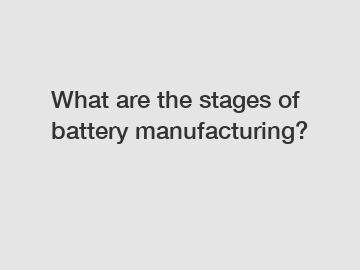What are the stages of battery manufacturing?
If you've ever wondered how batteries are made, you're in the right place. Battery manufacturing involves several stages that are essential to creating a reliable power source for various devices. Let's take a closer look at the process!
1. Raw Material Preparation.
The first stage of battery manufacturing involves gathering the necessary raw materials. This includes metals such as lithium, cobalt, and nickel, as well as other components like electrolytes and separators. These materials are carefully selected and processed to ensure they meet the required specifications.

2. Electrode Production.
Once the raw materials are prepared, the next stage is electrode production. Electrodes are the heart of a battery and play a crucial role in its performance. Each electrode is made by coating a metal foil with a paste containing active materials, binders, and conductive additives. These coated foils are then dried and cut into the desired shapes.
3. Cell Assembly.
The next stage in battery manufacturing is cell assembly. This involves stacking the positive and negative electrodes with separators in between, and then winding or stacking them into a cylindrical or prismatic shape. The assembled cells are then filled with electrolyte and sealed to prevent leakage.
4. Formation.
After cell assembly, the batteries undergo a process called formation. This involves charging and discharging the cells to activate the electrochemical reactions within the battery. Formation is crucial for stabilizing the battery's performance and ensuring it meets the required specifications.
5. Testing and Quality Control.
Once the batteries have been formed, they undergo rigorous testing and quality control checks. This includes measuring their capacity, voltage, and impedance, as well as conducting safety tests to ensure they meet industry standards. Any batteries that fail to pass the tests are discarded, while those that meet the requirements move on to the next stage.
6. Packaging.
The final stage of battery manufacturing is packaging. The batteries are placed in protective casings and labeled with important information such as voltage, capacity, and safety warnings. They are then packed into boxes or shrink-wrapped for transportation to customers.
Overall, battery manufacturing is a complex process that requires precision and attention to detail at every stage. By following these steps carefully, battery manufacturers can create high-quality, reliable power sources for a wide range of devices.
If you're looking for a reliable battery supplier for your business, don't hesitate to contact us. Our team of experts is here to help you find the perfect solution for your needs. Whether you need batteries for consumer electronics, electric vehicles, or energy storage systems, we can provide you with top-quality products at competitive prices. Contact us today to learn more about our services and how we can support your business.
Are you interested in learning more about lithium battery assembly line, prismatic lithium battery assembly machine, high-output battery module assembly line? Contact us today to secure an expert consultation!
Previous: Advantages of Galvanizing Kettle for Purchase Stage?
Next: New innovation in pallet wrapping technology: Game-changer?
If you are interested in sending in a Guest Blogger Submission,welcome to write for us!




Comments
0